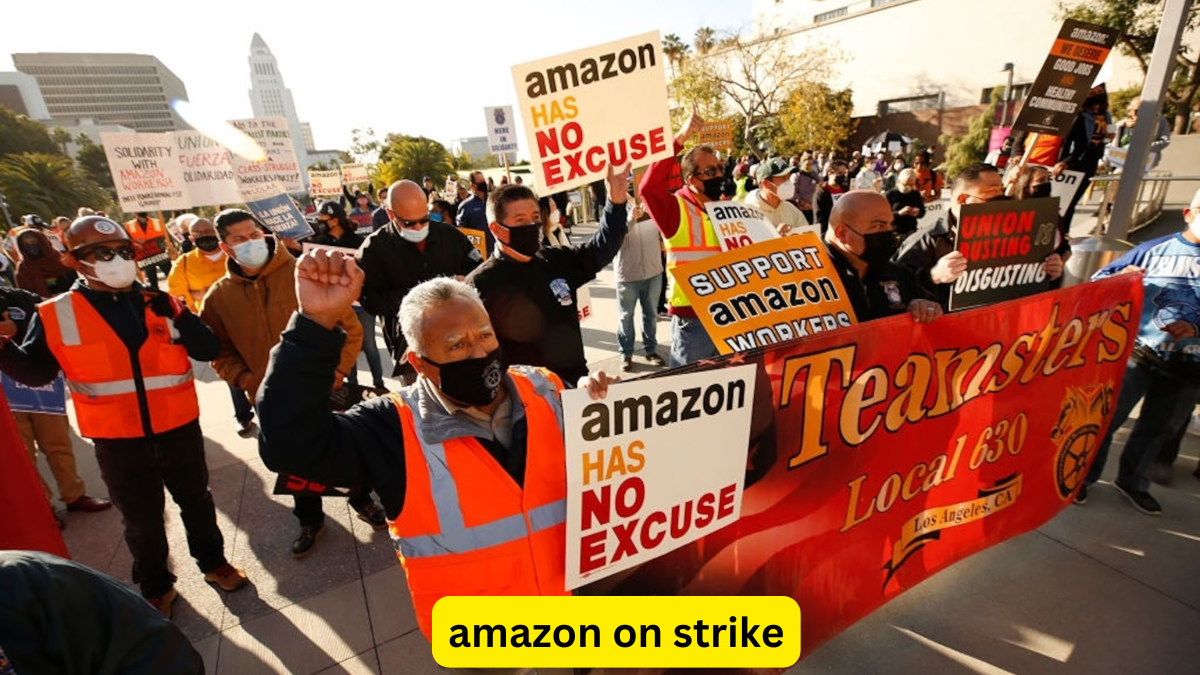Amazon on Strike:Amazon, one of the largest multinational corporations globally, has faced significant scrutiny for its labor practices in recent years. Employee dissatisfaction has culminated in a wave of strikes across various locations, highlighting concerns over working conditions, fair wages, and unionization. These events are reshaping the discourse on workers’ rights in the e-commerce and tech sectors. In this article, we examine the reasons behind these strikes, their impact, and what they mean for Amazon’s future.
Understanding the Reasons Behind the Strikes
Demand for Fair Wages
Amazon’s workforce, particularly its warehouse employees, has long advocated for higher wages. While the company claims to offer competitive pay, many workers argue that their wages do not reflect the physically demanding nature of their roles. This demand has gained traction in light of inflation and the rising cost of living.
For instance, warehouse employees have reported challenges in meeting basic needs despite working full-time. Strikes have called for a standardized pay increase across all fulfillment centers to address this disparity.
Improved Working Conditions
Working conditions in Amazon warehouses have often been described as grueling. Reports of long shifts, strict productivity quotas, and limited breaks have sparked widespread criticism. Employees have shared accounts of physically exhausting tasks and high injury rates, further intensifying calls for reforms.
Key demands include better safety protocols, more reasonable productivity targets, and the implementation of wellness programs to support employee health and morale.
Push for Unionization
A significant aspect of the Amazon strikes is the push for union representation. Workers argue that unions could provide a collective voice to negotiate better terms with the company. High-profile unionization efforts, such as those at Amazon’s Bessemer, Alabama facility, have highlighted the challenges workers face in organizing within the company.
Notable Strikes and Their Outcomes
The Staten Island Strike
One of the most prominent strikes occurred at Amazon’s Staten Island facility in New York. Workers at this location successfully formed a union in 2022, marking a historic moment for the company. The strike focused on securing higher wages, better benefits, and safer working conditions. This event has since inspired similar efforts at other Amazon facilities.
Black Friday Protests
Black Friday, one of Amazon’s busiest shopping days, has often been a focal point for worker protests. Strikes during this period aim to disrupt operations and draw attention to employee grievances. In 2023, coordinated protests across multiple countries demonstrated the growing solidarity among Amazon workers worldwide.
European Strikes
In Europe, Amazon workers have been at the forefront of strikes, particularly in countries like Germany, France, and Spain. These strikes have highlighted differences in labor laws and protections compared to the United States. European workers have often used collective bargaining and legal frameworks to secure better outcomes.
The Role of Public and Political Support
The strikes have garnered significant public attention, with many consumers expressing solidarity with Amazon workers. Grassroots movements and advocacy groups have amplified the voices of employees, calling for ethical business practices.
Politicians and labor leaders have also weighed in, with some advocating for stronger labor laws to protect workers in large corporations. High-profile endorsements have helped legitimize the strikes and put pressure on Amazon to address worker concerns.
Amazon’s Response to the Strikes
Increased Wages and Benefits
In response to mounting pressure, Amazon has announced wage increases and expanded benefits for certain employees. For example, the company raised its minimum wage to $15 per hour in the U.S., a move that was seen as a step in the right direction but insufficient by many workers.
Commitment to Safety
Amazon has pledged to improve workplace safety, citing investments in technology and training programs to reduce injuries. However, critics argue that these measures have not adequately addressed the core issues raised by employees.
Union Opposition
Despite these concessions, Amazon has maintained a strong stance against unionization. The company has invested heavily in anti-union campaigns, which has drawn criticism from labor advocates and employees alike. This opposition remains a contentious point in the broader discussion of workers’ rights.
The Broader Implications of the Strikes
Impact on E-Commerce and Tech Industries
The Amazon strikes have set a precedent for other companies in the e-commerce and tech sectors. Competitors are closely watching how Amazon handles these challenges, as it could influence labor practices industry-wide.
Consumer Perception
Strikes and protests have raised questions about the ethics of shopping with Amazon. Some consumers have shifted their spending to support businesses with better labor practices, reflecting a growing trend of socially conscious consumption.
Regulatory Changes
The strikes have prompted discussions about updating labor laws to address the challenges posed by modern work environments. Policymakers are exploring ways to strengthen protections for gig workers and employees in tech-driven industries.
Looking Ahead: What’s Next for Amazon and Its Workers?
The future of Amazon’s workforce will likely depend on the company’s willingness to engage with employees and address their concerns meaningfully. Key priorities include:
- Listening to Employee Feedback: Creating channels for open dialogue to understand and resolve worker grievances.
- Embracing Unionization: Recognizing unions as partners in building a sustainable and fair workplace.
- Enhancing Workplace Culture: Investing in initiatives that prioritize employee well-being and satisfaction.
As strikes continue to shape the narrative around Amazon’s labor practices, the company has an opportunity to redefine its approach and set an example for the industry.
The Amazon strikes represent a critical moment in the fight for workers’ rights, underscoring the importance of fair treatment and equitable practices in today’s global economy. While challenges remain, the resilience and determination of Amazon employees are paving the way for meaningful change.

